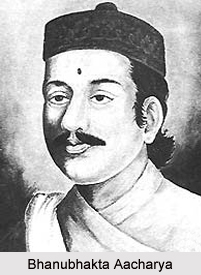 Bhanubhakta era in Nepali literature had commenced from 1872 A.D., lasting up to 1936 A.D. Almost half of the population from the Nepali language speakers are known to honour and esteem Bhanubhakta as the Adikavi (literally standing for `first poet`) of Nepali dialect and lexicon. His single most substantial and momentous contribution to Nepali literature is in all probability his translation of the Hindu epic Ramayana into Nepali language. This trailblazing composer had penned the Ramayana in metric form, utilising metres used in Sanskrit language. Bhanubhakta also had authored original poems on an assorted domain of subjects, ranging from family morals and advocacy of good will to sarcasm of bureaucracy and red tape and underprivileged and pitiable status of prisoners. However, this epoch was not free from its vices and moments of darkness. During the Bhanubhakta era in the gradually gathering Nepali literature, the whole nation was bashed and bonked by the catastrophic and devastating Sugauli Sandhi (a treaty that caused Nepal to drop major territory that had been annexed during the rule of Rana Bahadur Shah. The territory lost encompassed picturesque hill stations like Darjeeling and Sikkim (presently in India) and this was a major blow to the soldiers). Hence, the dichotomous impression was also witnessed to have impacted upon its national literature. Being fed up and browbeaten with polities, the writers veered course towards mythology and writings related to lores.
Bhanubhakta era in Nepali literature had commenced from 1872 A.D., lasting up to 1936 A.D. Almost half of the population from the Nepali language speakers are known to honour and esteem Bhanubhakta as the Adikavi (literally standing for `first poet`) of Nepali dialect and lexicon. His single most substantial and momentous contribution to Nepali literature is in all probability his translation of the Hindu epic Ramayana into Nepali language. This trailblazing composer had penned the Ramayana in metric form, utilising metres used in Sanskrit language. Bhanubhakta also had authored original poems on an assorted domain of subjects, ranging from family morals and advocacy of good will to sarcasm of bureaucracy and red tape and underprivileged and pitiable status of prisoners. However, this epoch was not free from its vices and moments of darkness. During the Bhanubhakta era in the gradually gathering Nepali literature, the whole nation was bashed and bonked by the catastrophic and devastating Sugauli Sandhi (a treaty that caused Nepal to drop major territory that had been annexed during the rule of Rana Bahadur Shah. The territory lost encompassed picturesque hill stations like Darjeeling and Sikkim (presently in India) and this was a major blow to the soldiers). Hence, the dichotomous impression was also witnessed to have impacted upon its national literature. Being fed up and browbeaten with polities, the writers veered course towards mythology and writings related to lores.
The most striking and noteworthy authors of the Bhanubhakta era in Nepali literature and their major works comprise:
Bhanubhakta Aacharya: He is not only the vital and most essential personality of this era, but also an unsurpassed and incomparable legend of Nepali literature. Bhanubhakta was born in Ramgha village of Tanahu district; his father`s name was Dhananjaya Aacharya. His grandfather Shree krishna Aacharya had taken all pains to take Bhanu Bhakt to Kasi, where he was later to receive splendid opportunity to study and move on further. But, after his grandfather`s death, Bhanubhakta was almost forced to had to return back to Nepal. Bhanubhakta`s several legendary conversations and tête-à -tête with grass-seller have found pride position in much folklore and later works of his.
Works of Bhanubhakta Aacharya: Ramayan, Badhu Shiksha, Bhakta Mala, Prasnotari, Ram Gita, Few letters to Ram Nath, Tamasukas, Applications etc.
Basanta Padhya Luientel: Basanta Padhya Luientel was born in 1860 at Katuja village of Bhadagaun and had expired in 1901 A.D.
Works of Basanta Padhya Luientel : Shree Krishna Charitra, Shamundra Lahari
Yadu Nath Pokhrel: Born in Shaptari, Yadu Nath Pokhrel had grown up to be a patriotic and had voraciously penned about Nepali army`s bravery and Bhim Sen Thapa`s thoughtful and diplomatic leadership. In all probability, Yadu Nath Pokhrel is the first poet to make use of English words during the Bhanubhakta era in Nepali literature.
Works of Yadu Nath Pokhrel : Stutipadhya, Krishna Charitra.
Hinbya Karni Bidhayapati: Hinbya Karni Bidhayapati was the foremost individual to have ushered in lyrical poetry into Nepali literature of the Bhanubhakta era. He is probably the first poet also who is accredited to have penned liberally about matters related to sexuality.
Works of Hinbya Karni Bidhayapati : Geet Baani, Saat Raag, Saat Naika.
Lalit Tripura Shunderi: She is famous and acknowledged as monarch Rana B. Shah`s youngest wife. It is also believed that in 1888 Lalit Tripura Shunderi had translated Raaj Drarma.



















